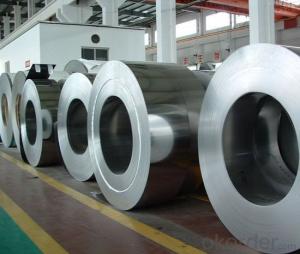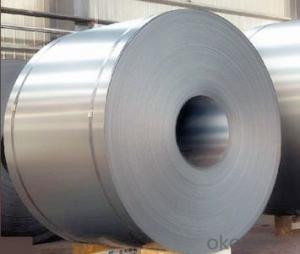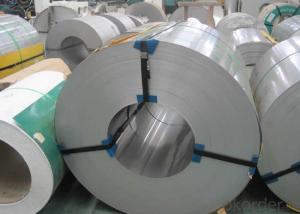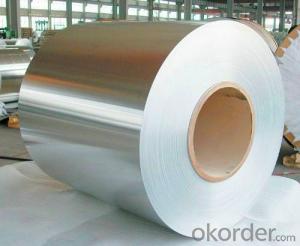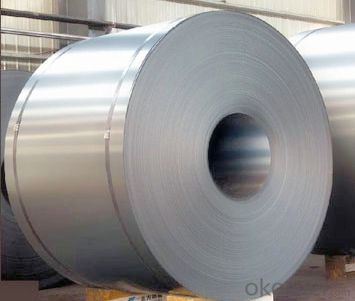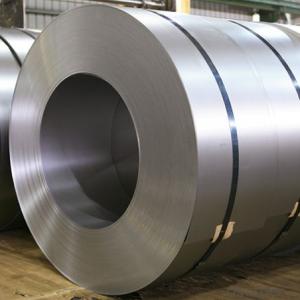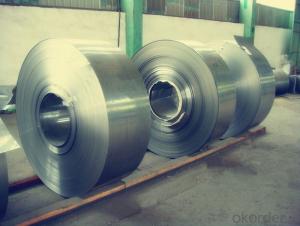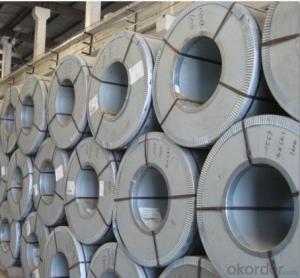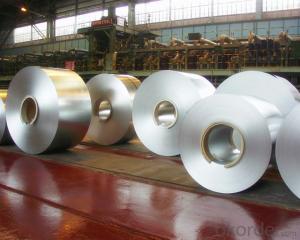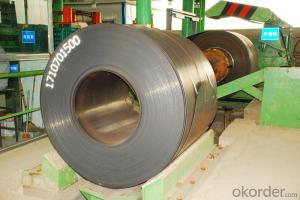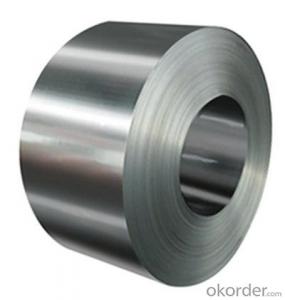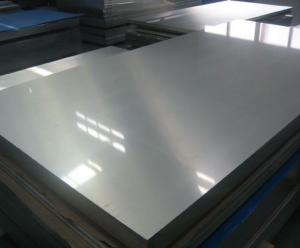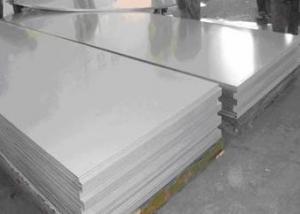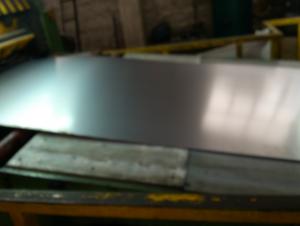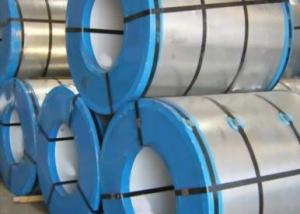Hot / Cold Rolled Stainless Steel Coil 201
- Loading Port:
- Lianyungang
- Payment Terms:
- TT OR LC
- Min Order Qty:
- 100 m.t.
- Supply Capability:
- 5000 m.t./month
OKorder Service Pledge
OKorder Financial Service
You Might Also Like
Hot Rolled Stainless Steel Coil 201 Narrow Strip No.1 Finish
Hot Rolled Stainless Steel 201 half copper Chemical Composition(%) | |||||||
C | Si | Mn | P | S | Ni | Cr | Cu |
0.1 | 0.5 | 10 | 0.04 | 0.01 | 1.20/1.30 | 13.00/14.00 | 0.8/1.0 |
Grade: | 200 Series | Standard: | JIS,AISI,ASTM,GB,DIN | Thickness: | 2.5/3.0/4.0mm |
Width: | 485/510/550/610/1010/1240mm | Place of Origin: | Shanghai China (Mainland) | Brand Name: | CNBM |
Model Number: | 201 | Technique: | Hot Rolled | Application: | Industrial tubes/kitchen/bath |
Certification: | ISO | THK: | 2.5/3.0/4.0mm | Face: | No.1 |
Usage: | tubes/kitchen/bath | Origin: | CHINA | ||
Packaging Detail: For customer's requirement
Delivery Detail: 10-30days
201 Hot Rolled Stainless Steel Coil Specifications
THK:2.3/2.5/3.0/4.0mm
Width:485/510/550/610/1010/1240mm
Face:No.1
201 Hot rolled stainless steel Coil Application
Stainless steel is a production which not easy rust,acid resistance and corrosion resistance,so it is widely
used in light industry,heavy industry,daily necessities and the decoration industry.
201 hot rolled stainless steel coil, use to produce cold rolled stainless steel coil and stainless steel tube, pipe.
201 Hot Stainless Steel Coil Chemical Composition(WT%)
(C):≤0.15, (Si):≤0.75, (Mn):5.5~7.50, (Cr):16.0~18.0, (N):≤0.25, (Ni):3.50~5.50, (P):≤0.060, (S):≤0.030
201 Hot Rolled Stainless Steel Coil
Strength Of Extension:100,000 To 180,000 Psi;
Yield Strength:50,000 To 150,000 Psi
Elongation :55 To 60%;
Modulus Of Elasticity:29,000,000 Psi;
Density :.280lbs/Cubic Inch(7.93g/Cm3)
- Q: Can stainless steel strips be used in oil and gas applications?
- Indeed, oil and gas applications can make effective use of stainless steel strips. Given its exceptional resistance to corrosion, stainless steel proves itself as an optimal choice for environments that involve exposure to corrosive substances like oil and gas. Moreover, stainless steel possesses remarkable strength and durability, both of which are crucial for enduring the high pressure and extreme temperatures typically encountered in oil and gas operations. In this regard, stainless steel strips find utility in various components including pipes, valves, fittings, and tanks, ensuring dependable functionality and longevity throughout the entirety of oil and gas operations.
- Q: How do you prevent stainless steel strips from rusting?
- To prevent stainless steel strips from rusting, there are several measures you can take: 1. Regular cleaning: Stainless steel should be cleaned regularly with mild soap or detergent and warm water. This helps remove any dirt, grime, or contaminants that can promote corrosion. 2. Avoid abrasive cleaners: Harsh or abrasive cleaners can scratch the surface of stainless steel, creating micro-abrasions where rust can start. Stick to non-abrasive cleaners and soft cloths or sponges for cleaning. 3. Dry thoroughly: After cleaning, make sure to dry the stainless steel strips completely. Moisture left on the surface can lead to rust formation. Use a clean, dry cloth or towel to remove any remaining moisture. 4. Remove rust spots promptly: If you notice any rust spots forming on the stainless steel strips, it's crucial to remove them as soon as possible. Use a stainless steel cleaner or a mixture of baking soda and water to gently scrub away the rust. Rinse thoroughly and dry the area to prevent further corrosion. 5. Apply a protective coating: There are various protective coatings available specifically designed for stainless steel. These coatings create a barrier between the metal and the environment, preventing rust formation. Follow the manufacturer's instructions for application and reapplication. 6. Avoid contact with corrosive substances: Stainless steel should be kept away from corrosive substances such as acids, bleach, or saltwater. If contact occurs, immediately rinse the affected area with plenty of clean water and dry it thoroughly. 7. Store in a dry environment: When not in use, it's essential to store stainless steel strips in a dry environment. Moisture and humidity can contribute to rust formation. Consider using desiccant packs or silica gel to absorb any moisture in the storage area. By following these preventative measures, you can significantly reduce the chances of your stainless steel strips rusting and ensure their longevity and appearance for years to come.
- Q: How do you store stainless steel strips?
- Stainless steel strips can be stored in a dry and clean environment, preferably in a well-ventilated area to prevent moisture buildup. It is recommended to keep them in a horizontal position, either stacked on a flat surface or in specially designed racks to avoid bending or warping. Additionally, it is crucial to protect them from contact with other metals or materials that could cause scratching or corrosion. Proper labeling and organization can also help in easily identifying and accessing specific strips when needed.
- Q: Can 111 stainless steel strips be used in the automotive industry?
- Yes, 111 stainless steel strips can be used in the automotive industry. Stainless steel is widely used in the automotive sector due to its excellent corrosion resistance, high strength, and durability. The specific grade 111 stainless steel is known for its good formability and weldability, making it suitable for various automotive applications. These strips can be used in the construction of car bodies, exhaust systems, fuel tanks, and other components where resistance to corrosion and high mechanical properties are required. Additionally, the use of stainless steel strips in the automotive industry helps enhance safety, improve fuel efficiency, and reduce overall vehicle weight.
- Q: What is the flexibility of stainless steel strips?
- The flexibility of stainless steel strips varies depending on their thickness and composition. Generally, stainless steel strips are relatively flexible and can be bent or shaped to a certain extent without breaking. However, the level of flexibility may be limited compared to other materials such as aluminum or plastic.
- Q: What are the factors affecting the hardness of 111 stainless steel strips?
- The factors that can affect the hardness of 111 stainless steel strips include the composition of the steel, the heat treatment process used, the amount of cold work or deformation applied, the presence of impurities or alloying elements, and the cooling rate during solidification and heat treatment. Additionally, the grain size and microstructure of the steel can also influence its hardness.
- Q: Are stainless steel strips suitable for pressure piping?
- Yes, stainless steel strips are suitable for pressure piping. Stainless steel is known for its excellent corrosion resistance, high strength, and durability, making it a preferred material for various applications, including pressure piping. Stainless steel strips can withstand high pressure and temperature conditions, making them suitable for use in industries such as oil and gas, chemical processing, and power generation. Additionally, stainless steel strips offer superior resistance to both internal and external corrosion, ensuring the integrity and longevity of the pressure piping system.
- Q: Can stainless steel strips be used in petrochemical applications?
- Indeed, petrochemical applications do allow for the use of stainless steel strips. Renowned for its remarkable resistance to corrosion, stainless steel proves to be an appropriate material for environments subject to extensive chemical exposure, including petrochemical plants. By withstanding the deleterious effects of petrochemicals, stainless steel guarantees the equipment's durability and longevity. Moreover, its exceptional strength and heat resistance properties amplify its suitability for petrochemical applications. Hence, stainless steel strips find frequent employment in the fabrication of diverse petrochemical equipment, encompassing tanks, pipelines, heat exchangers, and reactors.
- Q: How do stainless steel strips handle exposure to acids?
- Stainless steel strips are highly resistant to the corrosive effects of acids. This is due to the presence of chromium in the composition of stainless steel, which forms a protective oxide layer on the surface of the metal. This oxide layer acts as a barrier, preventing the acid from coming into direct contact with the steel and thereby reducing the risk of corrosion. Additionally, stainless steel also contains other alloying elements such as nickel and molybdenum that further enhance its resistance to acids. However, it is important to note that the performance of stainless steel strips can vary depending on the specific type and concentration of acid being exposed to. In some cases, certain aggressive acids may still cause some degree of corrosion, especially at elevated temperatures or prolonged exposure. Therefore, it is advisable to consult with a corrosion specialist or refer to specific guidelines to ensure the appropriate grade of stainless steel is chosen for a particular acid exposure application.
- Q: Can stainless steel strips be used in the automotive exhaust system?
- Indeed, the utilization of stainless steel strips is possible within the automotive exhaust system. Given its exceptional resistance to corrosion, high temperature strength, and durability, stainless steel stands as a favored material for exhaust systems. Utilizing stainless steel strips, one can fashion an array of exhaust system components, such as pipes, mufflers, and catalytic converters. These strips are capable of withstanding the harsh conditions inherent in the exhaust system, including elevated temperatures, moisture exposure, and the presence of corrosive gases. Moreover, stainless steel provides commendable aesthetics and can be effortlessly formed and welded, thus rendering it a versatile material for automotive exhaust systems.
Send your message to us
Hot / Cold Rolled Stainless Steel Coil 201
- Loading Port:
- Lianyungang
- Payment Terms:
- TT OR LC
- Min Order Qty:
- 100 m.t.
- Supply Capability:
- 5000 m.t./month
OKorder Service Pledge
OKorder Financial Service
Similar products
Hot products
Hot Searches
Related keywords
